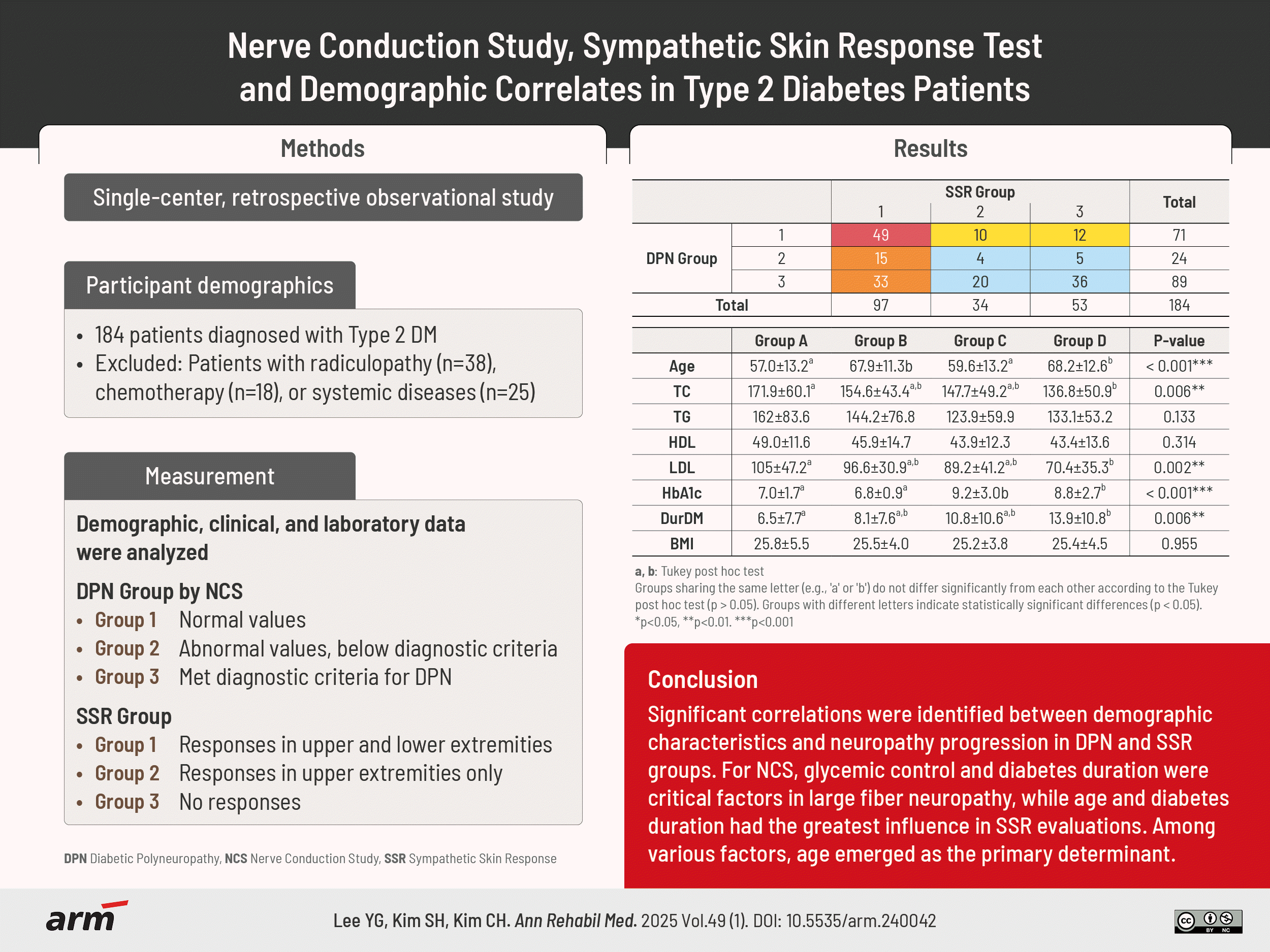2. Yang H, Sloan G, Ye Y, Wang S, Duan B, Tesfaye S, et al. New perspective in diabetic neuropathy: from the periphery to the brain, a call for early detection, and precision medicine. Front Endocrinol (Lausanne). 2020; 10:929. DOI:
10.3389/fendo.2019.00929. PMID:
32010062.

3. Kucera P, Goldenberg Z, Kurca E. Sympathetic skin response: review of the method and its clinical use. Bratisl Lek Listy. 2004; 105:108–16. PMID:
15253529.
4. Vetrugno R, Liguori R, Cortelli P, Montagna P. Sympathetic skin response: basic mechanisms and clinical applications. Clin Auton Res. 2003; 13:256–70. DOI:
10.1007/s10286-003-0107-5. PMID:
12955550.
5. Braune HJ, Horter C. Sympathetic skin response in diabetic neuropathy: a prospective clinical and neurophysiological trial on 100 patients. J Neurol Sci. 1996; 138:120–4. DOI:
10.1016/0022-510x(96)00023-8. PMID:
8791249.

6. Shin JB, Kim C, Lee JH, Chun S. Sympathetic skin response in diabetic patients. J Korean Acad Rehab Med. 1994; 18:286–92.
7. Lee IS, Kim HS, Ahn KH. Sympathetic skin response in diabetes mellitus. J Korean Acad Rehabil Med. 1993; 17:165–76.
8. Müller G, Parfentyeva E, Olschewsky J, Bornstein SR, Schwarz PE. Assessment of small fiber neuropathy to predict future risk of type 2 diabetes. Prim Care Diabetes. 2013; 7:269–73. DOI:
10.1016/j.pcd.2013.08.001. PMID:
24076379.

10. Dyck PJ, Giannini C. Pathologic alterations in the diabetic neuropathies of humans: a review. J Neuropathol Exp Neurol. 1996; 55:1181–93. DOI:
10.1097/00005072-199612000-00001. PMID:
8957441.
11. Han EY, Kim CH. Reproducibility of nerve conduction study parameters: a comparison of normal and diabetic patients with neuropathy. J Korean Acad Rehabil Med. 2007; 31:699–704.
12. Feldman EL, Callaghan BC, Pop-Busui R, Zochodne DW, Wright DE, Bennett DL, et al. Diabetic neuropathy. Nat Rev Dis Primers. 2019; 5:41. DOI:
10.1038/s41572-019-0092-1. PMID:
31197153.

13. Román-Pintos LM, Villegas-Rivera G, Rodríguez-Carrizalez AD, Miranda-Díaz AG, Cardona-Muñoz EG. Diabetic polyneuropathy in type 2 diabetes mellitus: inflammation, oxidative stress, and mitochondrial function. J Diabetes Res. 2016; 2016:3425617. DOI:
10.1155/2016/3425617. PMID:
28058263.

14. Levy DM, Reid G, Rowley DA, Abraham RR. Quantitative measures of sympathetic skin response in diabetes: relation to sudomotor and neurological function. J Neurol Neurosurg Psychiatry. 1992; 55:902–8. DOI:
10.1136/jnnp.55.10.902. PMID:
1331334.

15. Emad M, Roshanzamir S, Dabbaghmanesh A, Ghasempoor MZ, Eivazlou H. Inclusion of height and limb length when interpreting sympathetic skin response. Iran J Med Sci. 2016; 41:48–52. PMID:
26722145.
16. Oh TJ, Lee JE, Choi SH, Jang HC. Association between body fat and diabetic peripheral neuropathy in middle-aged adults with type 2 diabetes mellitus: a preliminary report. J Obes Metab Syndr. 2019; 28:112–7. DOI:
10.7570/jomes.2019.28.2.112. PMID:
31294343.

17. Smith AG, Singleton JR. Obesity and hyperlipidemia are risk factors for early diabetic neuropathy. J Diabetes Complications. 2013; 27:436–42. DOI:
10.1016/j.jdiacomp.2013.04.003. PMID:
23731827.

18. Zhang H, Chen Y, Zhu W, Niu T, Song B, Wang H, et al. The mediating role of HbA1c in the association between elevated low-density lipoprotein cholesterol levels and diabetic peripheral neuropathy in patients with type 2 diabetes mellitus. Lipids Health Dis. 2023; 22:102. DOI:
10.1186/s12944-023-01865-5. PMID:
37443036.

19. Chang KC, Pai YW, Lin CH, Lee IT, Chang MH. The association between hyperlipidemia, lipid-lowering drugs and diabetic peripheral neuropathy in patients with type 2 diabetes mellitus. PLoS One. 2023; 18:e0287373. DOI:
10.1371/journal.pone.0287373. PMID:
37319238.

20. Cai Z, Yang Y, Zhang J. A systematic review and meta-analysis of the serum lipid profile in prediction of diabetic neuropathy. Sci Rep. 2021; 11:499. DOI:
10.1038/s41598-020-79276-0. PMID:
33436718.

21. Jende JME, Groener JB, Rother C, Kender Z, Hahn A, Hilgenfeld T, et al. Association of serum cholesterol levels with peripheral nerve damage in patients with type 2 diabetes. JAMA Netw Open. 2019; 2:e194798. DOI:
10.1001/jamanetworkopen.2019.4798. PMID:
31150078.

22. Nozawa K, Ikeda M, Kikuchi S. Association between HbA1c levels and diabetic peripheral neuropathy: a case-control study of patients with type 2 diabetes using claims data. Drugs Real World Outcomes. 2022; 9:403–14. DOI:
10.1007/s40801-022-00309-3. PMID:
35725984.

23. Lai YR, Chiu WC, Huang CC, Tsai NW, Wang HC, Lin WC, et al. HbA1C variability is strongly associated with the severity of peripheral neuropathy in patients with type 2 diabetes. Front Neurosci. 2019; 13:90. DOI:
10.3389/fnins.2019.00090. PMID:
30814926.

24. Lee WJ, Jang S, Lee SH, Lee HS. Correlation between the severity of diabetic peripheral polyneuropathy and glycosylated hemoglobin levels: a quantitative study. Ann Rehabil Med. 2016; 40:263–70. DOI:
10.5535/arm.2016.40.2.263. PMID:
27152276.

25. Ashar I, Yudiyanta , Asmedi A. Correlation of HbA1c level with electrodiagnostic parameters of diabetic autonomic neuropathy. Berkala Neurosains. 2020; 19:120–5.




 PDF
PDF Citation
Citation Print
Print




 XML Download
XML Download